The Tramways of Mexico City: Part 2 (original) (raw)
The Tramways of Mexico City (Ciudad de México)
BY
Allen Morrison
The Mexico City chapter is divided into four parts.Go to Part 1: Animals, steam and gasoline
Part 3: After the Revolution
Part 4: The STE in Color
Part 2: Early Electrics
Mexico's first electric tramway - its first electric railway of any kind - opened in Nuevo Laredo, Tamaulipas state, in 1890. The first electric tramway in Mexico City was a battery-powered line that Alejandro Escandón, governor of the Federal District, operated from 1896 to 1900 around the grounds of the Hacienda de la Condesa in Tacubaya [number **9** on the milestones map]. The 1897, 1898, 1899 and 1900 editions of the Anuario Estadístico [see BIBLIOGRAPHY] reported 1.3 km of 914 mm gauge track. No pictures or other information about this mysterious tramway could be found.
On 14 April 1896 the Compañía de Ferrocarriles del Distrito Federal, the principal tramway operator in the city [see Part 1], received permission from the government to electrify its lines. A group of Canadian and European investors formed Mexico Electric Tramways Co. in London on 13 April 1898, purchased the CFDF and its franchise the following August, and began a massive construction project. MET - known locally as Tranvías Eléctricos de México - would electrify and operate the lines. Its subsidiary, CFDF, would buy and own the cars. The following inscription appeared on the new company's letterhead:
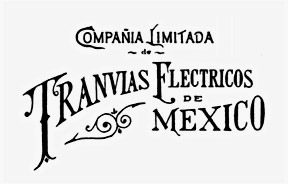
and the symbol below appeared on its cars:

CFDF ordered 60 electric streetcars from J. G. Brill Co. in Philadelphia: 36 vehicles on 26 June 1898 and 24 more on 12 October 1899. The second batch included two 8-wheel doubledeckers and 13 motorized funeral trams. On 15 January 1900 a flotilla of electric trams inaugurated the city's first trolley line, from the Indianilla tram sheds to Tacubaya - approximately the same route as the city's first horsecar line 42 years before [see **10** on map]. The ministers of Mexico, Japan and Russia, Capt. Porfirio Díaz, the son of Mexico's president, and Canadian engineer A. E. Worswick rode the first car [col. AM]:
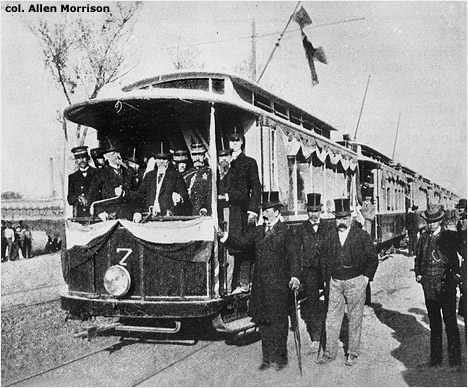
At first, the public - and a local cartoonist - did not appreciate the advantages of electric traction [col. AM]:
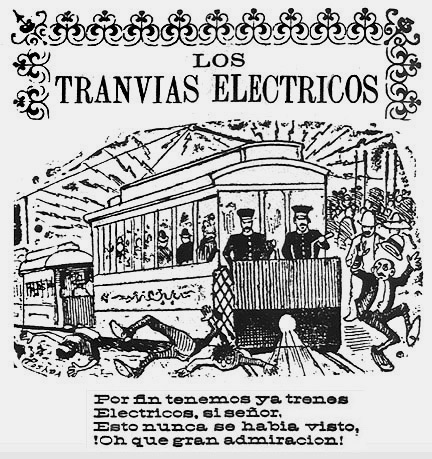
["Finally we have electric trams, yes sir. Nothing like it has been seen before and everybody loves them!"]
The postcard view below shows one of the original Brill cars pulling a former horsecar past Chapultepec Park [see map]. Note the "CFDF" insignia [col. AM]:
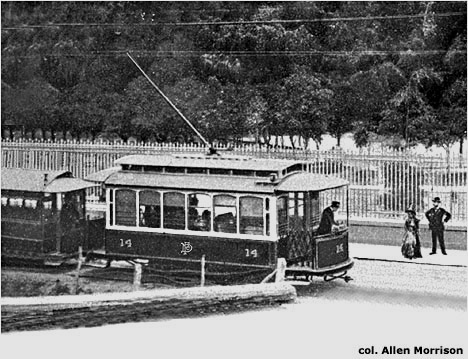
During the next ten months MET opened six more electric tram lines! New trolleycars began carrying passengers to Villa de Guadalupe in February, to Peralvillo in April, Mixcoac in May, San Angel in June, Tlalpan in October and Dolores Cemetery in November [see map]! By the end of 1900 MET had 97 km of electric tram route.
Meanwhile, CFDF ordered 135 more trams: 30 from American Car, 55 from St. Louis Car and 50 more from Brill, including four more doubledeckers and six 18-bench open trailers. St. Louis cars 36-50 were similar to the Brill 1-35 series shown above [pc, col. AM]:
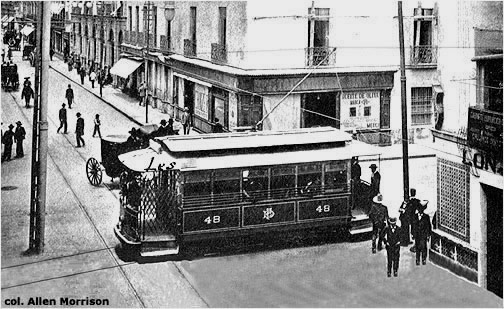
The 72-passenger doubledeckers entered service in 1901. The public loved them, but the company did not: they derailed frequently and were difficult to position because of their weight. One turned over on a curve. Five were rebuilt as singledeck cars 950-954 [pc, coll. AM]:
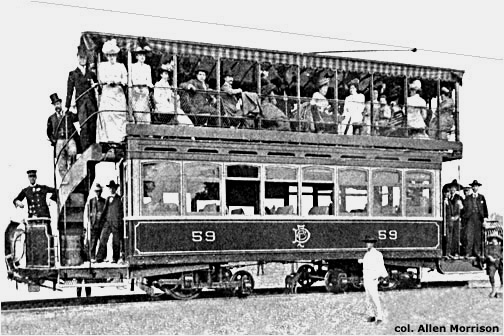
Here are the six open trailers in the Indianilla barn. Except for two "Metropolitan" cars (half open, half closed) built later, these were the only open trams to run in Mexico City. Note knee-to-knee seating [Modern Mexico, New York, 1/1903, p. 46]:
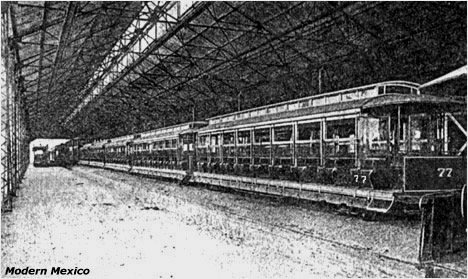
The postcard below shows the variety of equipment in 1904. The electric car pulling a trailer in the foreground is number 37 from St. Louis. The car next to it is a Brill. Both have had their front platforms enclosed. The doubledeckers may already have disappeared [col. AM]:
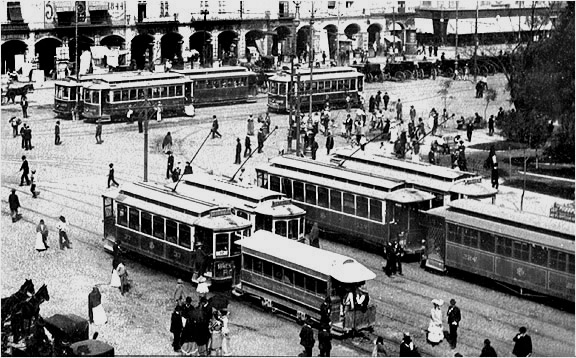
Passengers await their car on the Zócalo [see map] [col. AM]:
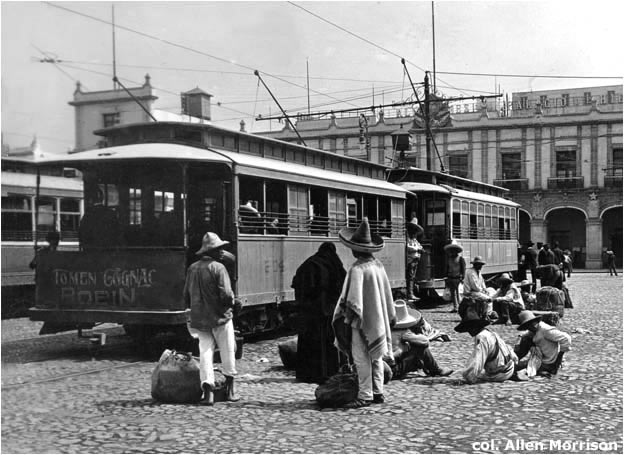
Ninety percent of the city's deceased were transported to cemeteries on the trams of the CFDF. There were eventually 90 funeral vehicles of every size and style for every budget. The car below is one of the original Brill vehicles of 1899. Family and friends rode in the trailer behind [postcard, col. AM]:
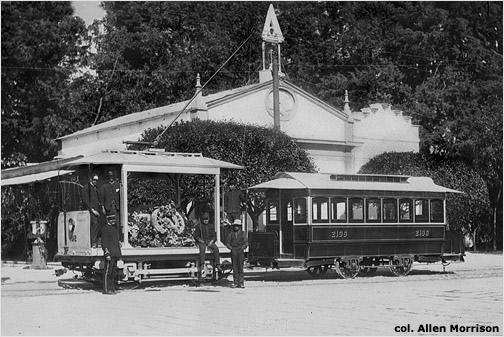
Here is a larger, one-piece model, built by St. Louis Car Co. in 1906 [Electric Railway Journal, New York, 1/5/1909, p. 820]:
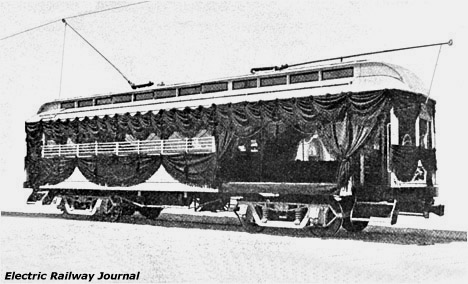
In 1906 MET operated 178 passenger motor cars, 28 funeral motor cars, 44 passenger trail cars, 72 freight motors and 79 freight trailers on its electric lines. On the lines that had not yet been electrified, some of which still used 914 mm gauge, it had 7 steam locomotives, 139 passenger cars, 51 funeral cars, 205 freight cars, a hospital car and a tram for transporting prisoners.
In March 1906 a group of Canadian investors organized Mexico Tramways Company (without the word Electric) in Toronto. MTC acquired 75% of MET's stock, took control of its tramway system and developed Necaxa dam and power plant in Puebla state. Compañía de Tranvías de México - as it was called locally - removed all names and symbols from the sides of its cars and ordered 25 large trams from St. Louis for its suburban line to San Angel [see map] [Brill Magazine, Philadelphia, 3/1911, cover]:
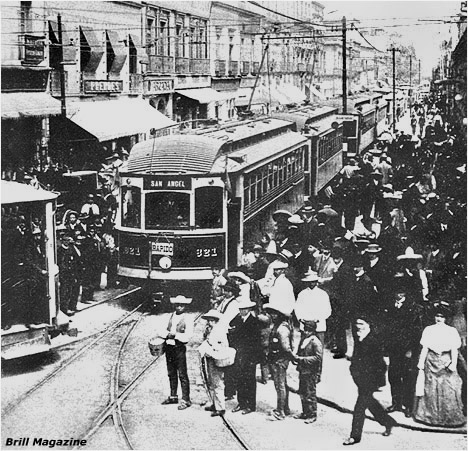
The stock certificate below shows the new cars - although the artist wasn't too good at trolley poles. The trams in front of the cathedral also have two poles pointed in the same direction - and are running left-handed, English-style [col. AM]:
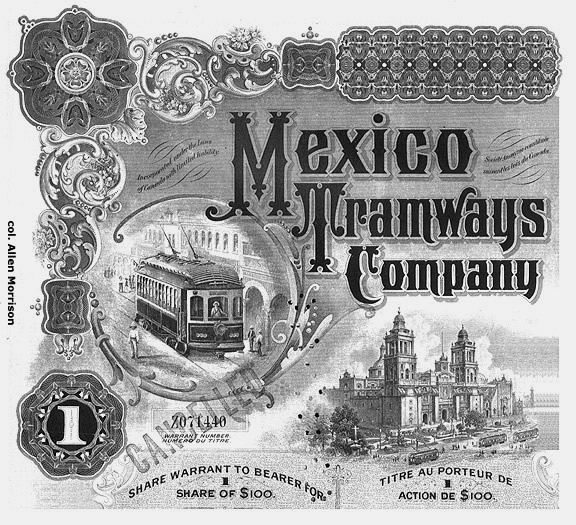
MTC also ordered several parlor cars from St. Louis, including this splendid specimen that recalled the Aztec regime [col. Luis León Torrealba]:
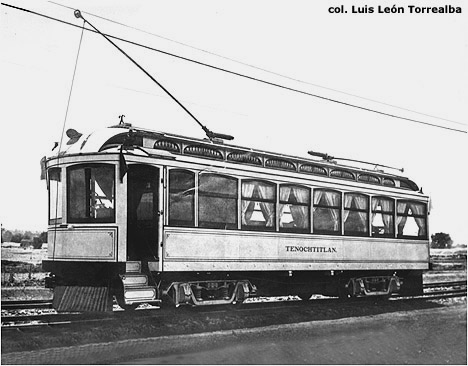
Another St. Louis car, the "Anahuac", provided sightseeing service from the Zócalo to San Angel, Coyoacán and Tlalpan [see map]. It was later rebuilt as a regular passenger car and numbered 430 [col. Luis León Torrealba]:
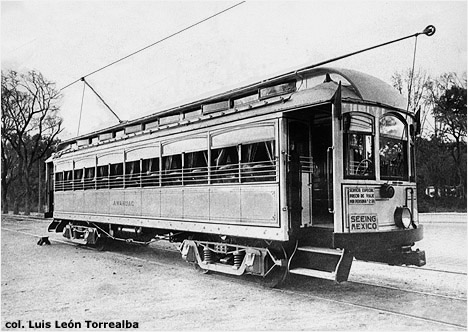
After 1907 MTC stopped importing trams for a while and began building, and rebuilding, vehicles at its Indianilla shops [see map]. It also renumbered many cars and made tramway research more difficult. Here is an interior view [col. AM]:
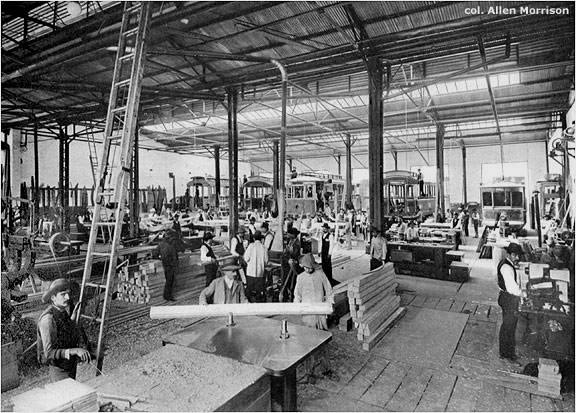
In 1908 a new line opened from the Zócalo southeast along La Viga Canal to Ixtacalco [see area map]. (The route was later extended to Ixtapalapa.) A 6-lane highway, Eje 2 Oriente, races through here today [postcard, col. AM]:
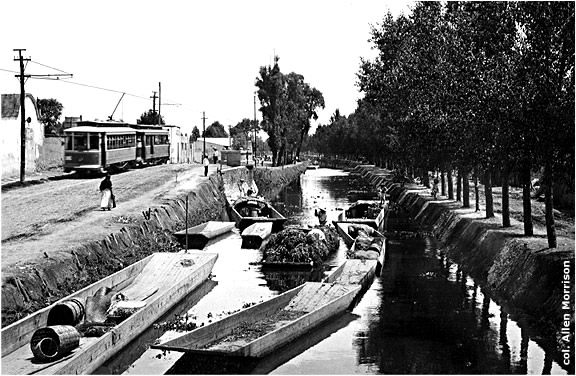
In 1909 MTC surveyed two interurban lines: a 147 km route from Huipulco east over the mountains to Puebla, and a 71 km route from Tacubaya west to Toluca, capital of México state. President Porfirio Días inaugurated the first 7 km of the Puebla line, from Huipulco to Xochimilco, on 12 July 1910. In 1912 the Toluca line opened as far as La Venta, 18 km west of Tacubaya, and the Xochimilco line was extended 11 km to Tulyehualco [see map].
The Revolution intervened and neither of these lines was built farther. Porfirio Díaz, Mexico's president since 1877, was forced from office by Francisco Madero in 1911. The postcard view below shows the celebration [col. AM]:
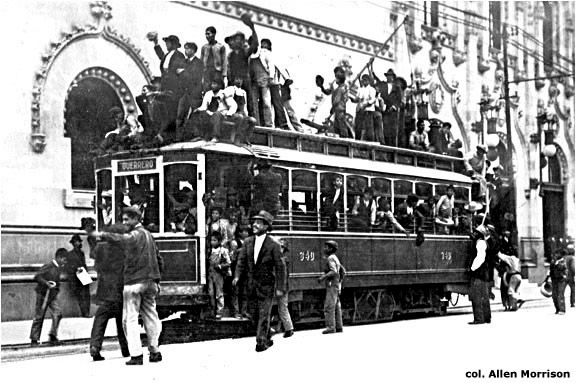
Tramway workers struck, the new Carranza government seized the controllers of the cars, and MTC stock paid no dividends for the next 30 years. Tramway operation resumed in 1915, but MTC control did not return until the end of the decade.
See Part 3: After the Revolution.
BIBLIOGRAPHY (in order of publication)"Novel Type of Street Car" in Street Railway Review (Chicago), 1/1899. Half-page article with description and photos of Brill-built car number 1.
"Street Railways in Mexico City" in Railway & Engineering Review (New York), 22/4/1899, p. 215. Electrification.
"Double-Deck Car for Mexico" in Street Railway Journal (New York), xx/1900, p. 478. The first Brill model. Photo and description.
"St. Louis Cars for Mexico" in Street Railway Review (Chicago), 20/7/1902, p. 421. Description and builder's photo of trailer car 221.
"Double Deck Cars for Mexico" in Tramway and Railway World (London), 13/3/1902, p. 156. Description and photo of second double-deck model.
"Mexico City's Electric Railways" in Modern Mexico (New York), 1/1903, pp. 46-47. Good article with excellent photos, including the one of open trail cars shown above.
"New Cars for the City of Mexico" in Street Railway Journal (New York), 30/7/1904, p. 48. Description and pictures.
"Compañía de Tranvías Eléctricos de México" in Guía Mensual: Passe-Partout de Ferrocarriles, Tranvías y Vapores. México, 5/1905, pp. 74-79. Itineraries and schedules of 23 electric routes; schedules of 16 animal-powered lines.
"Rolling Stock for the City of Mexico" in Electric Railway Review (Chicago), 10/1906, p. 659. Nice overview with picture of the first tram numbered 500 (there was another tram numbered 500 in 1928).
Percy F. Martin. Mexico of the Twentieth Century. London, 1907. Chapter XXVI, pp. 232-236, describes the present status of the tram system. Two photographs.
"Mexico Street Railways" in Electric Railway Review (Chicago), 22/2/1908, p. 231-232. A strong, not very positive account of daily operation.
"Making Street Cars Here" in Modern Mexico (México), 18/8/1908, p. 10. Description of trailer cars under construction by the company.
"Mexico from a Palace Street Car" in Modern Mexico (México), 12/1/1909, pp. 1-3. Inauguration of "Seeing Mexico" service. Detailed description of the tour. Three photographs.
"Electric Line Talked to Puebla" in Modern Mexico (México), 13/4/1909, p. 16. Surveying the interurban line to Puebla.
"Conditions of Electric Railway Operation in Mexico City" in Electric Railway Journal (New York), 1/5/1909, pp. 812-820. First major survey with detailed description, map, diagrams and 18 photographs. Excellent.
"Constructional and Operating Features of the Mexico City Tramways" in Electric Railway Journal (New York), 5/6/1909, pp. 1014-1023. Second half of survey above: 15 photographs, car plans, layout of Indianilla shops.
T, Philip Terry. Terry's Guide to Mexico. Boston, 1911. "Tramways" section describes itineraries in detail. Other editions provide similar information.
"Mexico City" in Brill Magazine (Philadelphia), 3/1911, pp. 62-72. Description, map and seven photographs, including one on the cover.
"The Tramways of the City of Mexico" in Tramway & Railway World (London), 15/1/1914, pp. 17-22. Text, 11 photographs and excellent full-page map.
"The Mexican Revolution" in Américas (Washington), 7-8/1985, pp. 3-4. An article about the photographer Gustavo Casasola includes a nice view of a streetcar strike.
Mario Camarena. "El Tranvía en época de cambio". Dirección de Estudios Históricos del INAH. Historia #27 (10/1991-3/1992), pp. 140-147. Essay on how the city was developed by its trams. Emphasis on early 20th century.
[Information about operation during this period is also contained in historical surveys published later; see **BIBLIOGRAPHY** for Part 3: After the Revolution.]
Go to Part 1: Animals, steam and gasoline
Part 3: After the Revolution
Part 4: The STE in Color
Return to INTRODUCTION & INDEX MAP